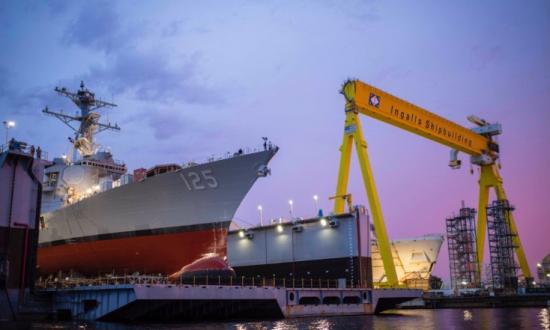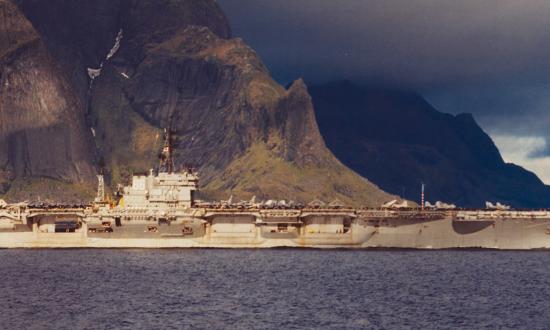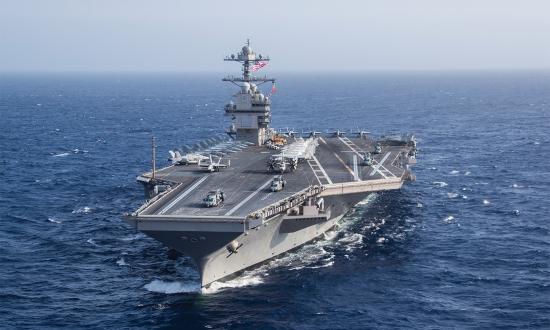Maritime warfare has always been defined by the relationship between sailors and their machines. From the Roman corvus to the birth of ocean-going sailing warships, to the cannon, to the airplane, and onto the computer and radio, sailors have always grappled to incorporate new technologies into their warfighting repertoire.
The birth of naval aviation, now celebrating its 100th anniversary, was no different. How should sailors use the new technology of airplanes in a naval context? Putting one or two or three land-based aircraft on cruisers and battleships seemed to be an effective way of using naval aviation to enhance those ship’s normal warfighting duties: scouting and long-range gun combat. In the end, sailors quickly determined that masses of land-based airplanes operating from a new form of ship held the most promise. The aircraft carrier, a form of ship never seen or conceived before, has dominated naval combat ever since.
With the advent and slow growth of uncrewed vehicles, how should sailors incorporate them into current concepts of maritime dominance? As with the birth of aviation, land based uncrewed or ummanned vehicles (UxVs) dominate today’s conceptual and operational implementation. Some ships and submarines, and perhaps a few aircraft are now adopting UxVs in at-sea operations, mirroring the seaplane era of naval aviation.
Surface combatants have been largely unchanged in form since the HMS Devastation was launched in 1871. Engines mounted deep in the hull, mechanical drive train with propellors and propeller shafts, guns in centerline turrets, and a high midships superstructure for height of eye and fire control. Subsequent warships added radio, airplanes, sonar, radar, missiles, satellite communications, digital computers, and electronic warfare systems. Narrow hulls were designed for tactical speed and maneuverability and prodigious fuel capacity was added for range. However, nothing has really changed in their general layout (i.e., form)—for 151 years!
Today, we face a far different world in technology. Electric propulsion, drones, ubiquitous computing, additive manufacturing, and—most of all—constant, unrelenting technology change, everywhere and in everything. It is time to move away from the 19th century surface combatant form.
Not Your Father’s Warship
As a thought experiment, what form might future surface combatants take?
Warships can be built low and flat; think of a double-wide USS Zumwalt (DDG-1000) with the superstructure lopped off. A boogie board with a flat top, jutting wave-piercing bow, tumblehome sides, a deep, high-volume underwater hull, a full stern gate, side access ports for wet uncrewed surface vehicles (USVs), hot refueling and rearming, many uncrewed aerial vehicles (UAVs), elevators or ramps to the flight deck from the hanger bay and the boat bay, an internal moon pool for clandestine deployment of unmanned underwater vehicles (UUVs), and possibly small port and starboard off-axis electromagnetic catapults to launch strike UAVs. A centerline low-profile navigation bridge right forward married to a large, aft-facing flight control facility. Peripheral vertical missile launchers. Gas-turbine generators mounted above the waterline for peak power demands and one or more small nuclear reactors buried deep in the hull for cruise power. A peripheral electric propulsion system.
Long-range air and missile defense radar faces can be installed low and at the extreme outboard corners of such a ship, once they are relieved of the burden of surface horizon detection and terminal self-defense missions. “Beamy” ships are more stable, so the emitters would have improved accuracy and range.1
Low, flat, beamy, stable warships can mount more vertically oriented antennas, increasing their access to space-based assets across a broader spectrum of frequencies without compromising the ship’s radar signature. Commercial as well as military satellite connectivity can be substantially improved. Ships of that form could accommodate the high-volume, high-power pulse-forming networks supporting electric weapons. Low, flat, beamy ships are structurally stronger, more damage resistant, and inherently stealthy.
The term “sea change” was first coined by William Shakespeare.2 His meaning was like the modern concept of a “paradigm shift”—underlying facts and/or understanding of them changes markedly.3 The need for surface-borne sea power persists. The ocean environment is unchanged. What has changed is how navies meet those needs. Thus, the form of the ships required to meet those needs must now undergo a sea change.
Electric Weapons
First, lasers and high-power microwave systems are emerging as “electric” weapons as opposed to the existing chemically propelled weapons (guns, missiles, and rockets). Electric weapons require large, near-instantaneous bursts of electrical power. Substantial pulse-forming networks are required to support their operation; future weapons are high-volume consumers of shipboard space as well as power.
Propulsion
Electric propulsion is mature enough to proliferate through the fleet. In fact, the U.S. Navy is one of the few navies yet to widely adopt electric propulsion for warships. Electric propulsion removes the requirement for a linear arrangement of prime mover to propeller. Reduction gears are unnecessary. Propulsion motors can be located where needed and can drive propellors or propulsors. Motors can even be located outside the hull or distributed along the hull. Instead of large, singular machines, multiple small-power generators can be combined in artful ways. The advent of electric propulsion for airplanes has created a new research ecosystem for gas turbine electric generators, so what used to be a niche shipboard market is now an emerging, dynamic commercial market for small, powerful gas turbine electric generators.4 Mixed-fuel generators can be used in combination (diesel, hybrid, gas turbine, nuclear, etc.) without complex gearing or long, coupled, damage-susceptible, energy-wasting drive trains or high-volumetric combustion air-handling systems. Most important, there is no need to differentiate between propulsion power and ship’s service power to weapons. “Scotty, put more power to the shields” could become a viable command in a future electric warship.
Unmanned Platforms
Uncrewed (or unmanned) vehicles are maturing. UxVs are rapidly proliferating as off-ship vehicles for surveillance, intelligence, weapons deployment, and other maritime warfighting missions. They can be controlled, autonomous, or semiautonomous. However, these devices bring substantial shipboard infrastructure requirements. Launch and recovery, fueling, battery charging/swapping, mission-module-change capability, repair and maintenance requirements, communications, remote data-processing requirements, and weapons handling will dominate future warship design and form.
Just as they do today in aircraft carrier designs.
Recommendations
Today’s warships are built with high masts and elevated superstructures to maximize radar and antenna height-of-eye to extend detection ranges for surface, subsurface, and sea-skimming threats. With UAVs and USVs, however, height of “ship’s eye” is largely irrelevant. UAVs can be flown as high or as far as necessary to search the maritime domain. USVs can be placed at range in threat sectors to provide surface-based sensors and weapons. Armed UUVs can patrol the seas far beyond shipboard sonar ranges. Low-power radars can be flown or carried, but high-power airborne sensors would require ship’s power; hence, the need for tethered flight for specially configured UAVs carrying powerful radars at altitude.
Modern warships are built slim and long and have powerful engines for tactical speed. With UAVs and USVs able to search and attack hundreds of miles simultaneously in every direction, however, warships may no longer need that speed. UxVs provide the necessary tactical sprint capability. Strategic movement can be conducted at lower, more fuel-efficient speeds with less horsepower. Unrefueled global transits and unrefueled local operations become possible, reducing demand on potentially tenuous fuel supply chains. Warships can be built to maximize volume and stability to ease and enable UxV operations. Prodigious ammunition and fuel capacity for UxVs, UxV weapons, and shipborne ordnance would also dominate.
Today one, two, or three UxVs embark in a warship. In the future, how many uncrewed vehicles might be needed?
Consider the following scenario:
- A future surface combatant needs to maintain comprehensive 360-degree surface surveillance out to 200 miles. Eighteen UAVs placed in 20-degree sectors at an altitude of 5,000 feet, at range, could provide that coverage. With an average battery life of two hours, 216 such drones would be required.5 Assuming 25 percent losses because of mishaps, failures and weather, the future warship might carry as many as 270 surveillance UAVs, launching and recovering about six every hour.
- The same surface combatant conducts 20 UAV strikes, with each strike having a 50 percent attrition rate. Thirty-eight heavy strike drones could conduct five strikes (20+10+5+2+1). Adding 25 percent for wastage would yield a required capacity of 48 aerial strike drones, plus weapons.
- One tethered UAV carrying a high-power radar emitter could be deployed at a time, with three or four available as spares.
- The same surface combatant places a surface USV picket line at the horizon, each assigned to a 40-degree sector. Each has enough fuel to support an eight-hour patrol. Thus, 27 USVs would be required, or, with attrition, 34 USVs, with one or two launching every watch.
- If those same USVs have a strike capability, then an additional nine would be prudent, without impacting the picket line.
- If the same warship was to place UUVs on a 180-degree submarine threat axis with 30-degree sectors, and a 24-hour battery life, then six UUVs would be required. If they also had a strike mission, then another two (25 percent) would be needed, all with torpedo or missile capability. Such UUVs might displace five to ten tons, each.6 Launches and recoveries would occur a few times a day.
Thus, a future surface combatant should theoretically carry up to 373 UxVs: 318 UAVs plus four tethered UAVs, 43 USVs, and eight UUVs.
A famous European shipbuilder noted that, “Steel is cheap and air is free.”7 Certainly, it is true when compared with the price of silicon, turbines, and technology dense UxVs. A future surface combatant will be big, beamy, low riding, volume-blessed, flat topped, with moderate horsepower, and stealthy. Given the high rate of change for these technologies, it must also be modular and flexible. Weapons stations, radars, UxV workstations, data centers, communication antennas, and self-defense weapons must all be removable, changeable, and reconfigurable between deployments and even between missions. Power generators must be similarly configured; today’s five-megawatt generator must be upgradable to the next model 10-megawatt generator after five years and, later, the next decades’ 15-megawatt (but similarly sized) generator. Nuclear reactors must also be modular, containerized, and easily replaced or refueled.
Data and structural interface standards for equipment stations must be well defined and ironclad. Ship margins must be high. Today’s ships have 5 to 25 percent margins for displacement, power, cooling, and berthing. The new form warship must have 100 to 300 percent margins; what new technology awaits next year or in the next decade? Nobody knows.
Shipboard high-power radars, still needed for long-range air and space missions, would become force assets along with their long-range missiles, lasers, and rail guns. Self-defense would be conducted at today’s tactical ranges by UxVs and possibly vestigial shipborne terminal defense weapons, many of which might also be electric rail guns or lasers. It may even be appropriate to armor some parts of the ship; not to stop threat missiles, but to protect parts of the warship from its own chemically kinetic force-level missiles and copious UxV ammunition stocks.
Many shipboard support systems are already technically mature with well decks, moon pools, modular weapons stations, radars, and vertical launchers, self-forming networks and hyperconverged data centers. UxVs, rail guns, edge computing and lasers are still maturing—though rapidly. Surface combatants went from cannons firing 100 yards to naval rifles firing 12 miles in just 40 years (1865–1905). Those guns were subsequently replaced by supersonic missiles flying hundreds of miles in another 40-year burst (1950–1990).
A Change in Form, not Mission
The Navy must start experimenting with this emerging-form warship and develop an at-sea prototype. This is not a new concept. The USS Langley (CV-1) was converted from a collier as the Navy’s first sea-based test bed in the early days of naval aviation. USS Norton Sound (AVM-1) was converted from a seaplane tender to be the original afloat test bed for the Aegis combat system. Today’s Navy needs a large, new-form ship to test UxV, rail gun, and laser capability. Perhaps a decommissioned LHA/D with electric propulsion replacing her steam plant or a cut-down, decommissioned LPD or LSD; a ship with a well deck and expanded aviation capabilities. There must be enough room to allow for an integrated electric distribution system capable of supporting rapid experimentation, modular edge processing, and copious satellite communications—all to enable rapid UxV prototyping, operational evaluation, and assessment and fielding of new shipboard and off-board UxV support capabilities—enough to define a new production form for the Navy by the end of this decade.
1. Which is why DDG 51 ships are beamier than their predecessors.
2. Bill Bryson, Shakespeare (Eminent Lives) (New York: HarperCollins, 2019).
3. Thomas Kuhn, The Structure of Scientific Revolutions, (Illinois: University of Chicago Press, 1962).
4. Guy Norris, “Electric Push,” Aviation Week & Space Technology, 25 July to 7 August 2022, 87.
5. This is not possible today. It would take 25 to 40 minutes at best, unless they could be recovered, recharged, and launched remotely from a USV.
6. The current XLUUV protype displaces 10 tons, without any weapons capability.
7. American Society of Naval Engineers Total Ship Systems Conference, Global Shipbuilding Summit Panel “International Naval Shipbuilding Best Practices and Benchmark,” moderated by the author, virtual, 27 January 2021.






